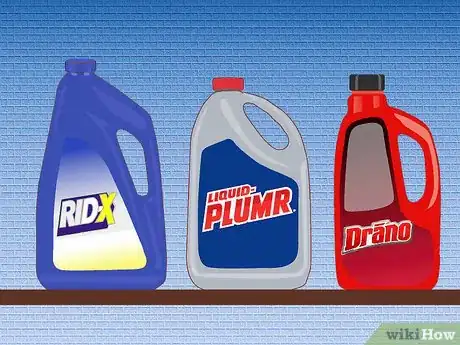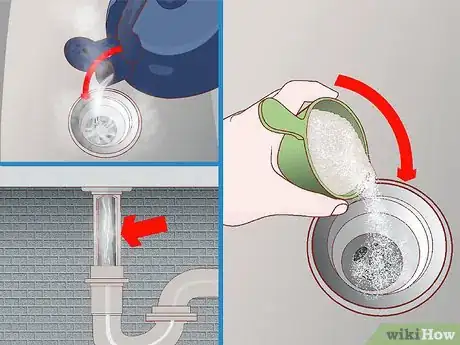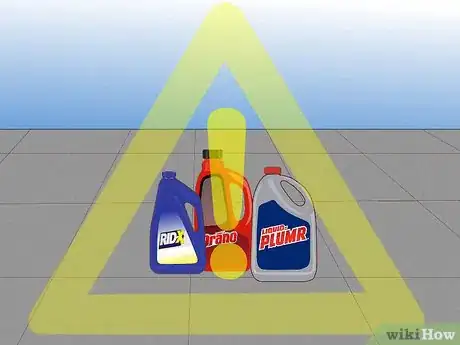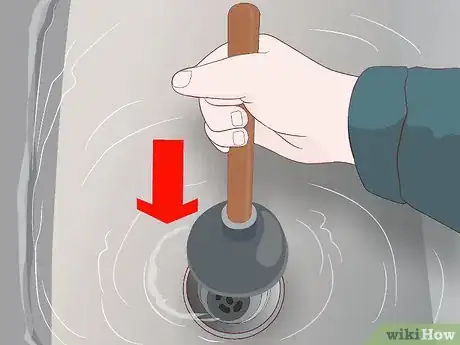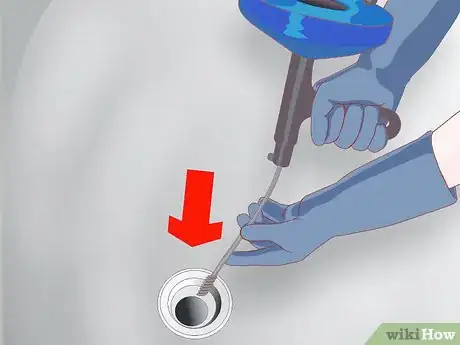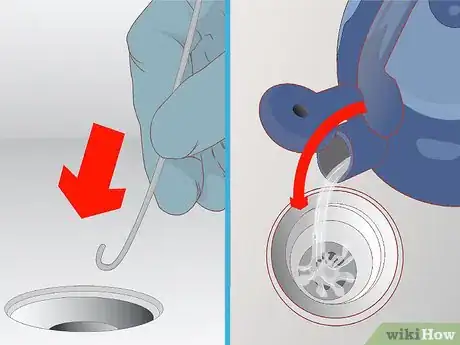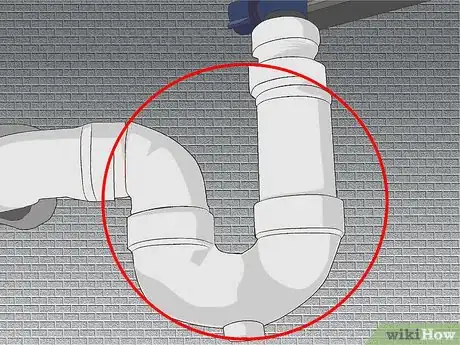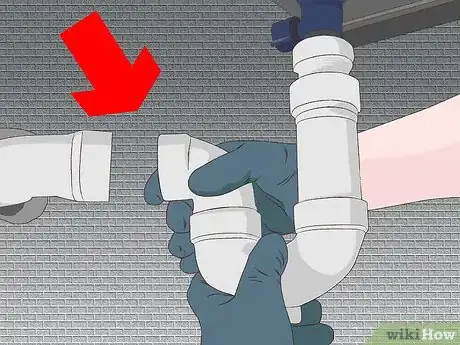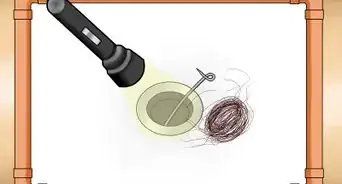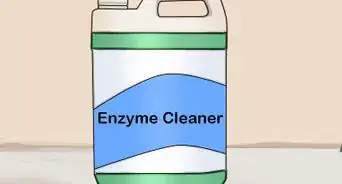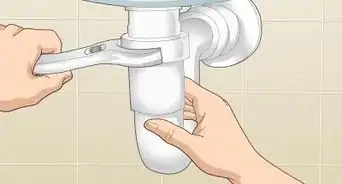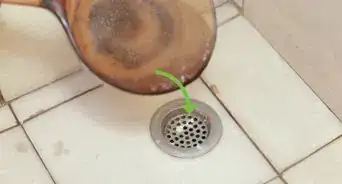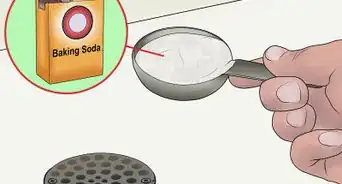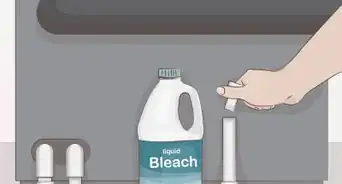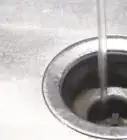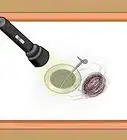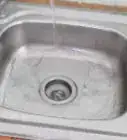This article was co-authored by David Balkan. David Balkan is a Professional Plumber, CEO of Balkan Sewer and Water Main Service, and President of Balkan Sewer and Drain Cleaning. As a hands-on owner of these companies for over 40 years, David is knowledgeable about water service lines, sewers, and drain line issues. David is a Committee Chairman of the Master Plumbers Council and has sat on the Executive Committee of the Sub Surface Plumbers Association of New York for over 30 years. His knowledge and solution-oriented approach contributed to Balkan Sewer and Water Main Service being the largest and most trusted service in New York City and the recipient of the 2017 Angie’s List Super Service Award.
This article has been viewed 529,194 times.
Are your pipes a pain in the drain? You can unclog your own pipes at home without the help – or the cost – of a professional plumber. Learning a few different techniques will help you be able to conquer even the toughest of drains.
Steps
Using Chemical Solutions
-
1Make your own unclogging mixture out of household supplies. Using vinegar, baking soda, and water is an effective, eco-friendly method of unclogging your pipes. The baking soda and hot water will loosen up any build-up that’s clogging your waste pipe, and the chemical reaction from the vinegar will cause the sludge to move on down the drain.
- Start by pouring a pot of boiling water down your drain.
- After you do this, pour 1/2 cup of baking soda down the drain and let it sit for 5 minutes.
- Follow this with a solution of 1 cup vinegar and 1 cup very hot water. Let it sit for 10 minutes.
- Pour one more pot of boiling water down the drain to flush away the scum that has been loosened up by the baking soda and vinegar.[1]
-
2Purchase liquid cleaners to unclog your pipes. One of the most common ways to clean out your waste pipes is to purchase liquid drain cleaner at your local convenience store. These chemical solutions are often very effective, but can sometimes cause damage to pipes if they are old or worn down.
- Popular liquid drain cleaners include Drano, Liquid Plumr, and Rid-X.
- The instructions for these products will be included on the bottle, but you will typically use an entire bottle to unclog stopped up pipes. The chemical solution will need to sit in place for a while, but be sure to rinse it out with hot water before taking a bath or shower.
Advertisement -
3Use a powder solution to clean your waste pipes. Some people prefer to use powder-based cleaners as opposed to liquid ones, as they are less corrosive on the pipes. Most of these powders contain the chemical Sodium Hydroxide, which works quickly to unclog drains. Because it works quickly, the product doesn't need to sit in the clogged drain for long periods of time to be effective.
- Popular powder cleaners are Thrift and Drain Care.
- When using these products, let hot water run through the pipes for 1-2 minutes before pouring the powder down the drain. Use roughly 2 cups of powder (more or less depending on the size of the drain), and let the powder sit for 2 minutes before rinsing with hot water.
-
4Be careful when using chemical substances. Chemical substances work by dissolving the scum, hair, and dirt that tends to clog drains and waste pipes. Because of this, these chemical products are usually extremely corrosive and may be harmful on older pipes. Take extreme caution when handling these products, as they can sometimes cause injury to your skin.
- To be extra cautious, only handle these products while wearing rubber gloves.
Using Tools to Unclog Your Drain
-
1Use a plunger. Using a plunger is a great way to clear clogged waste pipes – from your bathtub, to your toilet, to your sink. Plungers consist of a long, straight handle with a flexible rubber cup-type mechanism attached at the bottom. The rubber section acts as a suction cup to dislodge any blockages and force air and water to flow through the pipes.
- If standing water isn't already present in your tub / sink, add 2 to 3 inches of water. As you use your plunger, the water will help force whatever is obstructing the pipe out of the way.
- Seal any nearby drains with a rag or plug before you start plunging so there's more pressure.
- Place the plunger cup over the drain hole, and work the plunger's handle up and down repeatedly. Repeat this process a few times if your pipes are still draining slowly. After you clear the clog, run water to wash away remains of the obstruction.[2]
- Be careful using a plunger if you've recently poured chemicals down the clogged drain. Using a plunger can make the chemicals splash up and get on your skin.
-
2Use a drain snake. If your plunger does not clear the blockage, try using a drain snake. A drain snake is a long, flexible piece of steel attached to a handle that is used to dislodge the buildup that clogs pipes. A piece called an auger is at the front end of a drain snake, this piece is usually shaped like a spiral. They can be purchased at most hardware shops.
- Feed the snake down the drain, auger end first. As you insert the drain snake, twirl it around so that it can easily make its way through the pipe. Once you've inserted the drain snake, slowly begin to pull it back it out. This technique should be able to break-up the debris that is causing the clogging. You may have to repeat this a couple of times to guarantee that your pipes are free of obstructions.[3]
- You may be better off hiring a pro to snake your drain if you’ve never done it before. It’s surprisingly easy to accidentally puncture a pipe.
-
3Make your own drain snake out of a wire hanger. This is a great method to use if you don't have a plumber or drain snake lying around at home. Almost everyone can find a wire hanger somewhere in their closet, and that's all you'll need to make your very own drain snake. You may want to wrap the wire hanger with tape so it doesn't scratch up your toilet.
- Disassemble a wire coat hanger by unwinding the looped end of the wire from around the hook part of the hanger. If the wire is extremely stiff, use pliers instead of your hands to unwind the wire. Straighten the hanger as much as possible, using the pliers if you need assistance.
- Fold 1/4 inch of one end of your hanger onto itself to create a small hook. Use your pliers to fold and squeeze the hook into place.
- Slowly push the hook end of the homemade snake into the pipe,twirling the snake as it travels downward. Once you've inserted it all the way, slowly pull out the snake. Repeat this until the clog has been removed.
- Run hot water to rinse out remnants from the clog.[4]
-
4Try using a high-pressure drain blaster. High-pressure drain blasters are devices that blast air into a drain to unclog it. To use one, place the end on the clogged drain and pump the device several times to release a blast of air.
- You can find a high-pressure drain blaster online or at your local home improvement center.
Cleaning the Pipes
-
1Locate the obstruction. Is it inside the waste pipe outlet from the bathtub, the toilet, or perhaps in the kitchen sink? Obstructed waste pipes are likely to be the result of build-up of soap scum, hair, oil, or kitchen waste. The P-trap (sometimes called the U-bend trap) is the part of the pipe that needs to be disconnected and cleaned.
-
2Disconnect the P-trap of your pipe. P-traps (U-bend traps) are found beneath the plug hole of sinks and baths, and are found in the tank of toilets. This waste tube traps debris, prevents deep clogs from forming in your plumbing system, and to stops foul smelling gases and odors from passing into your home.
- Place a bucket or large bowl under your P-trap to catch the excess water when you unscrew the pipe.
- To remove a P-trap, use a wrench to unscrew the pipe’s retaining caps. Release the waste tube and pour out the water and debris. Then, flush out the P-trap with warm water to remove the remaining debris.
- You can then use a wire or drain snake to push out any debris obstructing the actual pipe.
- Replace the pipe and screw the caps back in place.[5]
-
3Keep your waste pipes clear. Prevention is preferable to cure, so take care of your pipes to prevent them from clogging. If you make an effort to clean your drains every 1-2 weeks, they'll be less likely to form clogs.
- Place strainers in all of your drains. These will stop debris (like hair, food, etc.) from entering your waste pipes.
- Run a drain cleaner through your pipes every few weeks to prevent sludge from building up.
- Run hot water through your garbage disposal after use to wash away excess debris.
Community Q&A
-
QuestionHow do I clear a sink waste water pipe of scale?
 Community AnswerCheap vinegar is good, but you need to give it a bit of time, or for a more powerful solution, you can get caustic soda (sodium hypochlorite) or boracic acid from the supermarket or hardware store. The cheap brand works just as well as the expensive one. Be careful and do not get any on your skin, it burns. Dilute it with water.
Community AnswerCheap vinegar is good, but you need to give it a bit of time, or for a more powerful solution, you can get caustic soda (sodium hypochlorite) or boracic acid from the supermarket or hardware store. The cheap brand works just as well as the expensive one. Be careful and do not get any on your skin, it burns. Dilute it with water. -
QuestionHow do I clear the clogged debris from the kitchen sink pipe outlet?
 SchraderplumbinghCommunity Answer.Go underneath the sink, line it with paper towels or a towel. Put a large bucket underneath the P-trap. Remove as much of the standing water as possible from the sink, whether with a pan or wet vac. Unscrew the P-trap, making sure what water still in the pipe drains into the bucket. Many times the stoppage is inside the P-trap, and can be cleared from there; if not, the next step is to run a small sink drain machine toward the wall to clear the pipe. You can rent a small kitchen sink machine at Lowe's or Home Depot, and they will show you how to use it.
SchraderplumbinghCommunity Answer.Go underneath the sink, line it with paper towels or a towel. Put a large bucket underneath the P-trap. Remove as much of the standing water as possible from the sink, whether with a pan or wet vac. Unscrew the P-trap, making sure what water still in the pipe drains into the bucket. Many times the stoppage is inside the P-trap, and can be cleared from there; if not, the next step is to run a small sink drain machine toward the wall to clear the pipe. You can rent a small kitchen sink machine at Lowe's or Home Depot, and they will show you how to use it. -
QuestionWhat are three examples of the causes of blockage?
 Community Answer1) solidified grease; 2) hair, food particles, coffee grounds, etc.; 3) soap scum (calcium stearate) buildup. This may form a thick, hard coating on the pipes and closes them off eventually.
Community Answer1) solidified grease; 2) hair, food particles, coffee grounds, etc.; 3) soap scum (calcium stearate) buildup. This may form a thick, hard coating on the pipes and closes them off eventually.
Warnings
- Be careful unclogging drains that lead to old and fragile cast iron pipes. If your home has older cast iron pipes, and gentle methods like baking soda, boiling water, and snaking aren't working, call a plumber for assistance so you don't accidentally break the pipes.⧼thumbs_response⧽
References
- ↑ http://www.crunchybetty.com/clean-your-drains-with-baking-soda-and-vinegar-surprise
- ↑ http://www.lowes.com/projects/bed-and-bath/clear-clogged-drain/project
- ↑ http://www.doityourself.com/stry/how-to-use-a-drain-snakes#b
- ↑ http://homeguides.sfgate.com/make-snake-unclogging-shower-drain-31939.html
- ↑ https://www.dummies.com/home-garden/home-improvement/kitchen-bath-remodeling/how-to-install-the-p-trap-under-a-sink/
About This Article
One way to clear a clogged waste pipe is by using chemicals. To use an at-home mixture, start by pouring a pot of boiling water down the drain, and then pour ½ cup of baking soda down the drain. Let the baking soda sit for 5 minutes, and then pour 1 cup of vinegar and 1 cup of hot water down the drain. Let it sit for 10 minutes, and then pour another pot of boiling water down the drain to flush away the clog that has been loosened by the chemicals. For tips on purchasing chemical cleaners and using tools to unclog the drain, scroll down!

